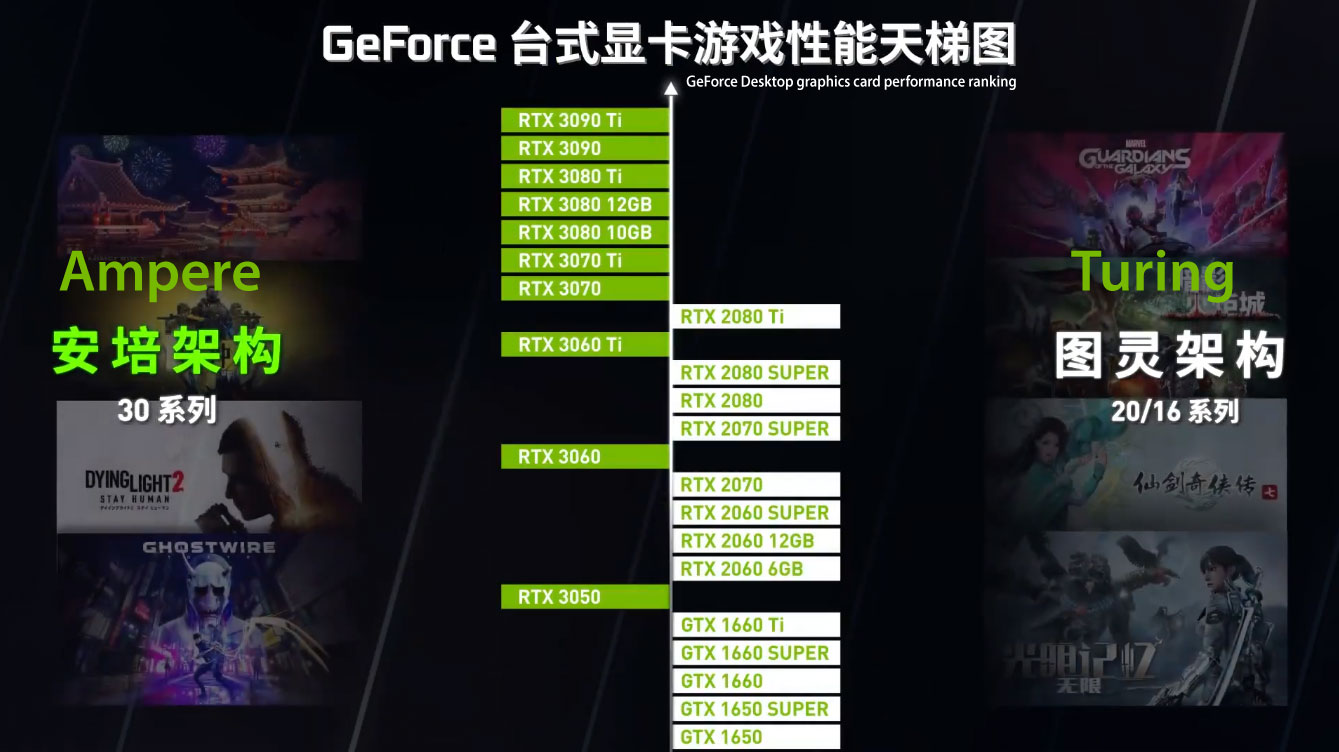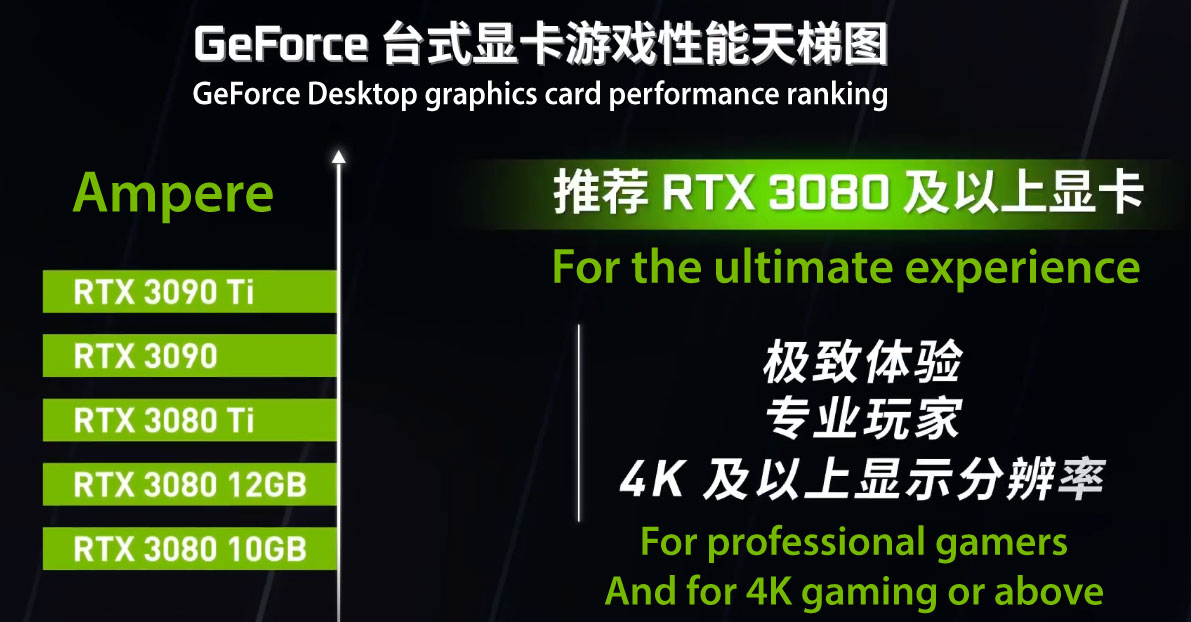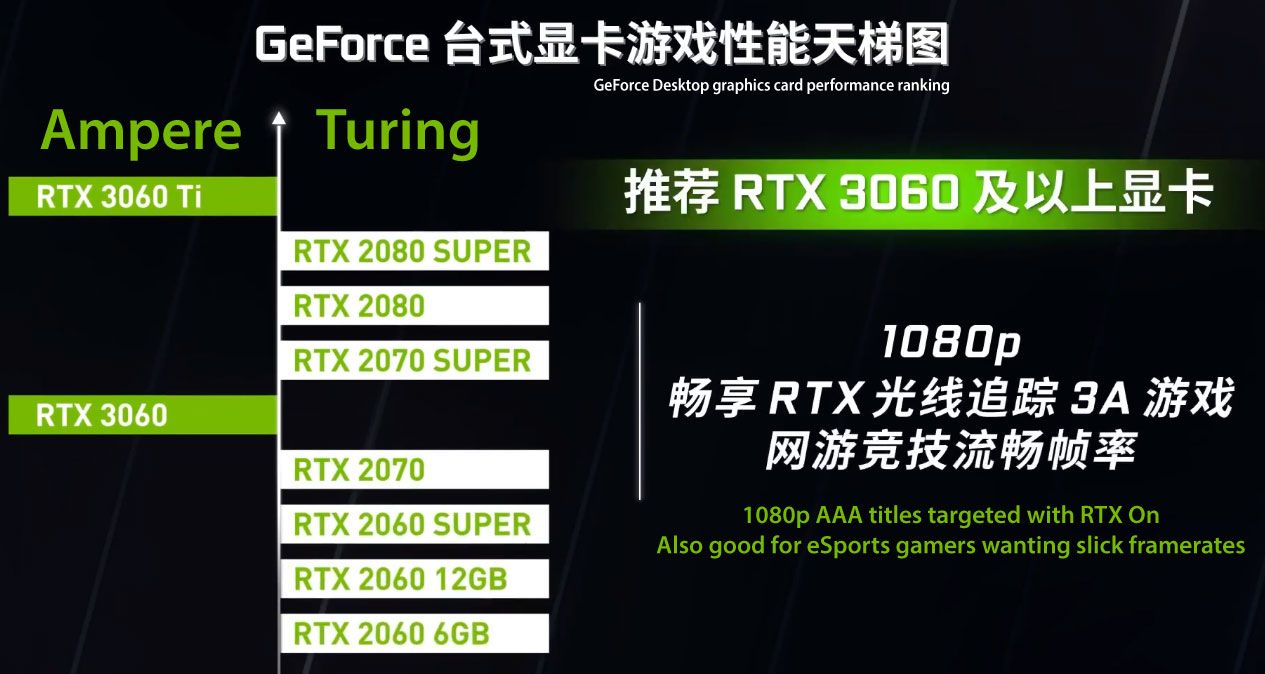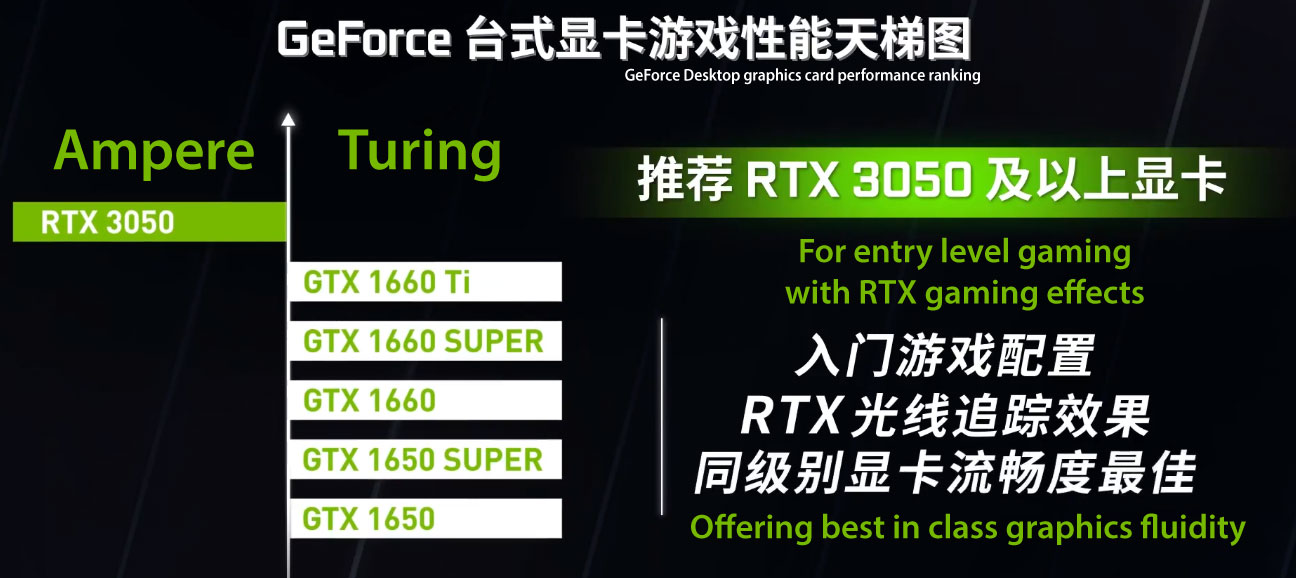Nvidia Hierarchy Shows the RTX 3050 Can't Keep Up With the Old RTX 2060
The Nvidia GeForce social media team in China has released an updated performance hierarchy video. It's an informative but brief watch, which helps make some sense of the diverse mix of GeForce graphics cards from RTX and GTX designations, with Ampere and Turing architectures, and from the GTX 16, RTX 20 and RTX 30 families. Perhaps the most jarring message from the green team is that it sees the new GeForce RTX 3050 as a member of its bottom tier of graphics cards, while the old RTX 2060 sits smugly in a category alongside the RTX 2080 / Super, RTX 2070 / Super, and RTX 3060 / Ti graphics cards.
In the video, Nvidia shows the comparative performance of the broad mix of Ampere and Turing CPUs currently sold worldwide. It also says what types of games, graphics quality settings, and resolutions each of its GPUs targets in 2022. Of course, the video is in Chinese, but we have translated all the important bits, so you can grasp the meanings of the annotations that pop up alongside the 'performance ladder'.
Starting from the top of the Nvidia performance ladder, if you are aiming for the "ultimate experience" at high resolutions (typically 4K) you will want to buy a GeForce RTX 3080 10GB or better. Nvidia has crowded a lot of cards into this expensive category and it doesn't provide any clear reason why you would splash out on anything better than the cheapest of the five GPUs listed here.
Meanwhile, for 1440p ultimate quality and smooth gameplay in modern AAA games, Nvidia recommends a GeForce RTX 3070 Ti, RTX 3070, or an RTX 2080 Ti. Compared to the packed field for 4K gaming, this is a somewhat limited choice but contains the last gen champ, the RTX 2080 Ti.
For 1080p gaming in AAA titles with raytracing turned on, the slide includes options from Ampere and Turing generations. The range of performance is very broad, and it's somewhat strange to see the RTX 2080 Super and RTX 2060 6GB on the same page while the RTX 3050 apparently doesn't make the cut. Nvidia doesn't explain any benefits of picks from higher up the ladder, but at 1080p some of these GPUs will be able to achieve very high frame rates with ultra quality and RTX effects while others like the RTX 2060 will struggle at times.
On the bottom rung of the ladder we get the entry level gaming tier, headed up by the GeForce RTX 3050. The text mentions RTX gaming effects, but the Ampere card is the only one that supports such effects in hardware.
It's a little sad to see that the Ampere RTX 3050 isn't able to outpace a Turing 2060. Things are a little off-balance here, as the RTX 3060 is claimed to beat the RTX 2070, and the RTX 3060 Ti is ahead of the RTX 2080 Super in the Nvidia performance ladder. Nvidia has cut the generational performance uplifts where gamers would appreciate it most, in the cheap seats.
Except, these seats aren't even that cheap. The RTX 2060 back in the day dropped below $300 in pricing on a regular basis. Right now, you can find RTX 2060 cards starting at $390, compared to the RTX 3050 starting at $350. Typical eBay prices peg the RTX 2060 at $326 versus $382, however. Considering even Nvidia admits the RTX 2060 is faster, the choice isn't so clear cut. It's a shame the supposed $250 starting price of the 3050 is yet to materialize.
Overall, Nvidia put some thought and effort into creating this hierarchy showing how it sees things. There aren't a lot of clear details on performance, however. For that, and for comparisons with AMD's hardware, you'll want to check out our own GPU Benchmarks and Hierarchy 2022. Not only does it include all of the recent GPUs, but we have charts and performance results going as far back as the GTX 780 and R9 390, the former of which launched clear back in 2013.
Get Tom's Hardware's best news and in-depth reviews, straight to your inbox.

Mark Tyson is a news editor at Tom's Hardware. He enjoys covering the full breadth of PC tech; from business and semiconductor design to products approaching the edge of reason.
-
InvalidError So, Nvidia is reminding us that the RTX3050 shouldn't cost anywhere near an RTX2060 or RTX3060.Reply -
tennis2 I mean...they literally had a shareholder meeting slide gloating that they're charging the customer more for a GPU, soooo.Reply
Supply and demand babyyyy!!! -
InvalidError Reply
Question is whether inflated prices will survive GPU-mining likely dying down once ETH2 launches and the mass sell-offs begin. The beyond-MSRP situation appears to be well on its way to sorting itself out as long as there isn't another industry-wide supply disruption to fudge things up again.tennis2 said:I mean...they literally had a shareholder meeting slide gloating that they're charging the customer more for a GPU, soooo.
Supply and demand babyyyy!!! -
Karadjgne What that video/nvidia doesn't say is the % difference. For all anyone knows the 2060 is only averaging 1% better than a 3050, which in reality makes them the same card and fits perfectly with nvidia's drop 10 next gen numbering scheme. Same applies to the 3060/2070 which bump heads consistently or close enough to be margin of error.Reply
My personal opinion is the 3050 is better than the 2060, uses better DLSS, better RTX, at gives a better 1080p gaming experience, regardless of a couple fps difference I can't see or tell exist in anything except a benchmark.
For general gaming, and all intents and purposes, a 1070, 1660ti, 2060 and 3050 all land in the same place±, the fps differences being so minor as to not realistically mean anything.
Making that hierarchy chart useless to anyone but a benchmark chaser. Imho. -
watzupken I think there are already a lot of reviews out there, whether written or on videos, that shows that the RTX 3050 is generally behind the RTX 2060. The only time it can catch up with the RTX 2060 is when that extra 2GB VRAM is used. But the fact is that it is generally not that far off from the RTX 2060. So if given a choice of RTX 2060 6GB vs RTX 3050 8GB, I feel the 3050 may still be a viable option as long as it is cheaper to make up for the performance loss.Reply -
waltari You are comparing wrong products. Price range wise 3050 is like what, 1660Ti? Its like comparing 2060 and 3080Reply -
Karadjgne $389.99 for Asus Dual 3050 ,130wReply
$389.98 for Gigabyte 2060 Gaming X, 215w
According to PCPartPicker.com as of this reply.
Considering the measly 3-5 fps difference, which honestly is margin of error % and close enough that an OC aftermarket version could easily tie the difference, the 3050 8Gb and 2060 6Gb are the same, except one has lowered power consumption which could be a benefit. -
renz496 isn't that review already show this? and we know 3050 based on GA106 will be slower than RTX2060 even before the card officially being launch.Reply



